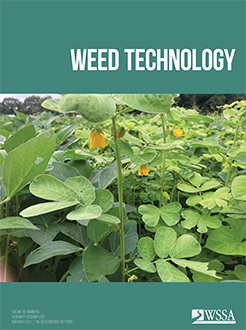In Mississippi, rice reproduction and ripening often overlaps with soybean maturation, creating potential for herbicide exposure onto rice from desiccants applied to soybeans. Six independent studies were conducted concurrently at the Delta Research and Extension Center in Stoneville, MS, from 2016 to 2018 to determine the response of rice to sublethal concentrations of soybean desiccants during rice reproductive and ripening growth stages. Studies included the desiccants paraquat, glyphosate, saflufenacil, sodium chlorate, paraquat + saflufenacil, and paraquat + sodium chlorate applied at a rate equal to 1/10th of Mississippi recommendations. Treatments were applied at five different rice growth stages, beginning at 50% heading––defined as 0 d after heading (DAH)––with subsequent applications at 1-wk intervals (0, 7, 14, 21, and 28 DAH), up to harvest. Injury was observed 7 d after application (DAA), with five of six desiccants at all application timings. No injury was observed with glyphosate application across all rating intervals. Rough rice grain yield following all glyphosate applications was reduced by >6%. In the studies evaluating paraquat, injury ranged from 5% to 18% at all evaluations, regardless of application timing. Rough rice grain yield was reduced >12% 0 to 21 DAH, following paraquat application. Similar trends were observed with paraquat + saflufenacil and paraquat + sodium chlorate, with rice exhibiting yield decreases >6% following an application 0 to 14 and 0 to 21 DAH, respectively. In studies evaluating saflufenacil and sodium chlorate, rough rice grain yield was >95% of the untreated across all application timings Yield component trends closely resembled reductions observed in rough rice grain yield. Reductions in head rice yield were >5% following applications of paraquat or paraquat + saflufenacil 0 to 14 and 0 to 21 DAH, respectively. Late-season exposure to sublethal concentrations of desiccant from 50% heading (0 DAH) to 28 DAH has an impact on rough rice grain yield, yield components, and head rice yield.
Nomenclature: Glyphosate; paraquat; saflufenacil; sodium chlorate; rice; Oryza sativa L.; soybean; Glycine max (L.) Merr.






